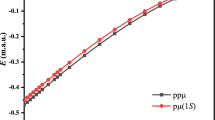Abstract
We investigate ion-orbital interaction in Car-Parinnello molecular dynamics (CPMD) analytically and numerically in order to probe the role of the fictitious orbital mass. We show analytically that this interaction can be described by linearly coupled oscillators when the system is sufficiently close to the ground state. This leads to ionic vibrational modes with frequency ωM that depends upon the ionic mass M and the orbital mass μ as \( {{{\omega }}_{\text{M}}}{ = }{{{\omega }}_{\text{0M}}}{{[1 - {\text C}(\mu /M)]}} \) in the limit of zero μ/M; ω0M is the Born-Oppenheimer ionic frequency and C depends upon the ion-orbital coupling force constants. This analysis provides new insight on the orbital mass dependence of the dynamics, and suggests a rigorous method of obtaining accurate ionic vibrational frequency using CPMD. We verify our analytical results with numerical simulations for N2, and discuss in detail the dynamical interaction between the ionic and the fictitious orbital modes in CPMD. Our results demonstrate that displacement from the ground state significantly affects ionic frequencies. In the linear regime this results in the linear dependence of ionic vibrational frequency upon μ/M. In the non-linear regime, even the ionic geometry deviates from the correct ground-state structure, highlighting the importance of staying close to the ground state in CPMD calculations.
Access this chapter
Tax calculation will be finalised at checkout
Purchases are for personal use only
Similar content being viewed by others
References
Car R, Parrinello M (1985) Unified approach for molecular dynamics and density-functional theory. Phys Rev Lett 55:2471–2474
Field MJ (1990) Simulated annealing, classical molecule dynamics and the Hartree-Fock method: the NDDO approximation. Chem Phys Lett 172:83–88
Hartke B, Carter EA (1992) Spin eigenstate-dependent Hartree-Fock molecular dynamics. Chem Phys Lett 189:358–362; Gibson DA, Carter EA (1997) Ab initio molecular dynamics of pseudorotating Li5. Chem Phys Lett 271:266–272; Liu ZH, Carter LE, Carter EA (1995) Full configuration interaction molecular dynamics of Na2 and Na3. J Phys Chem 99: 4355–4359
Sprik M, Klein M L (1988) J Chem Phys 89:7556–7560; Sprik M (1991) Computer simulation of the dynamics of induced polarization fluctuations in water. J Phys Chem 95:2283–2291
Rick SW, Stuart SJ, Berne BJ (1994) Dynamical fluctuating charge force fields: application to liquid water. J Chem Phys 101:6141–6156
Pastore G, Smargiassi E, Buda F (1991) Theory of ab initio molecular-dynamics calculations. Phys Revi A 44:6334–6347
Marx D, Hütter J (2000) Modern methods and algorithms of computational chemistry. In: Grotendo J (ed) Forschungszentrum Julich. Proceedings, vol 1
Car R, Angelis F, Giannozzi P, Marzari N (2005) First principles molecular dynamics. In: Yip S, Kaxiras E, Marzari N, Trout B (eds) Handbook of materials modeling: methods and models, vol 1. Springer, New York
Tangney P (2006) On the theory underlying the Car-Parrinello method and the role of the fictitious mass parameter. J Chem Phys 124:044111
Tangney P, Scandolo S (2002) How well do Car-Parrinello simulations reproduce the Born-Oppenheimer surface? Theory and example. J Chem Phys 116:14–24
Kuo IFW, Mundy CJ, McGrath MJ, Siepmann JI, VandeVondele J, Sprik M, Hutter J, Chen B, Klein ML, Mohamed F, Krack M, Parrinello M (2004) Liquid water from first principles: investigation of different sampling approaches. J Phys Chem B 108:12990–12998
Kuo IFW, Mundy CJ, McGrath MJ, Siepmann JI (2006) Time-dependent properties of liquid water: a comparison of Car-Parrinello and Born-Oppenheimer molecular dynamics simulations. J Chem Theory Comput 2:1274–1281
Ong SW, Tok ES, Kang HC (2010) Vibrational frequencies in Car-Parrinello molecular dynamics. Phys Chem Chem Phys 12:14960–14966
Tassone F, Mauri F, Car R (1994) Acceleration schemes for ab initio molecular-dynamics simulations and electronic-structure calculations. Phys Rev B 50:10561–10573
Giannozzi P et al (2009) Quantum ESPRESSO: a modular and open-source software project for quantum simulations of materials. J Phys Condens Matter 21:395502
Wathelet V, Champagne B, Mosley DH, Andre J, Massida S (1997) Vibrational frequencies of diatomic molecules from Car and Parrinello molecular dynamics. Chem Phys Lett 275:506–512
Becke AD (1988) Density-functional exchange-energy approximation with correct asymptotic behavior. Phys Rev A 38:3098–3100; Lee C, Yang W, Parr RC (1988) Development of the Colle-Salvetti correlation-energy formula into a functional of the electron density. Phys Rev B 37:785–789
Troullier N, Martins JL (1991) Efficient pseudopotentials for plane-wave calculations. Phys Rev B 43:1993–2006
Author information
Authors and Affiliations
Corresponding author
Editor information
Editors and Affiliations
Rights and permissions
Copyright information
© 2012 Springer Science+Business Media B.V.
About this chapter
Cite this chapter
Ong, SW., Tok, ES., Kang, H.C. (2012). Dynamical Role of the Fictitious Orbital Mass in Car-Parrinello Molecular Dynamics. In: Gupta Bhowon, M., Jhaumeer-Laulloo, S., Li Kam Wah, H., Ramasami, P. (eds) Chemistry for Sustainable Development. Springer, Dordrecht. https://doi.org/10.1007/978-90-481-8650-1_11
Download citation
DOI: https://doi.org/10.1007/978-90-481-8650-1_11
Published:
Publisher Name: Springer, Dordrecht
Print ISBN: 978-90-481-8649-5
Online ISBN: 978-90-481-8650-1
eBook Packages: Chemistry and Materials ScienceChemistry and Material Science (R0)




